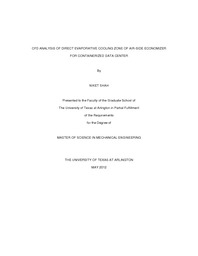
ATTENTION: The works hosted here are being migrated to a new repository that will consolidate resources, improve discoverability, and better show UTA's research impact on the global community. We will update authors as the migration progresses. Please see MavMatrix for more information.
Show simple item record
| dc.contributor.author | Shah, Niket | en_US |
| dc.date.accessioned | 2012-07-25T19:09:51Z | |
| dc.date.available | 2012-07-25T19:09:51Z | |
| dc.date.issued | 2012-07-25 | |
| dc.date.submitted | January 2012 | en_US |
| dc.identifier.other | DISS-11740 | en_US |
| dc.identifier.uri | http://hdl.handle.net/10106/11103 | |
| dc.description.abstract | Conventional data centers are extremely large buildings that have complex power distribution and cooling systems. These traditional brick and mortar data centers employ relatively expensive cooling systems and are inefficient. It has in turn led to an increase in construction and operational costs. Jonathan Koomey, Ph.D. of Lawrence Berkeley National Laboratory estimated that worldwide data center power consumption was 152.5 Billion kWh in 2005. In 2007, the US EPA estimated that servers and data centers, “consumed about 61 billion kilowatt-hours (kWh) in 2006 (1.5 percent of total U.S. electricity consumption) for a total electricity cost of about $4.5 billion. These inefficiencies of traditional data centers can be overcome by partitioning the server load into modular sections which can be deployed, powered and cooled depending on availability and requirement. Furthermore, improvements in efficiency and operational costs can be achieved by employing “free cooling” to cool the IT equipment through use of air-side economization. Air-side economizers bring in large amounts of ambient air to cool internal heat loads when weather conditions are favorable and result in substantial savings from the cost of running cooling resources. However, if ambient air properties are not suitable to cool information technology (IT) equipment directly, ambient air needs to be conditioned before entering IT equipment. One method of conditioning outside air is to use direct evaporative cooling which sprays atomized water as air passes through an evaporative cooling zone. Atomized water vaporizes and conditions air passing through the cooling zone by adding moisture and reducing its temperature, thus foregoing expensive computer air conditioning units (CRACs). The first part of the thesis will discuss various cooling techniques available for air-side economizer. The effect of various ambient environment conditions corresponding to different controls and/or environmental conditioning are required to optimize energy efficiency is studied. ASHRAE recommended Psychrometric chart for the operating environment is used to determine the water requirements for direct evaporative zone. In the second phase, computational fluid dynamics (CFD) analysis is performed using commercially available CFD tool, Fluent, to determine the performance of direct evaporative cooling in an air-side economizer. Various factors that affect performance of evaporative cooling, such as particle sizes of atomized water, ambient air temperature and humidity, water temperature are invested in this study. | en_US |
| dc.description.sponsorship | Agonafer, Dereje | en_US |
| dc.language.iso | en | en_US |
| dc.publisher | Mechanical Engineering | en_US |
| dc.title | CFD Analysis Of Direct Evaporative Cooling Zone Of Air-side Economizer For Containerized Data Center | en_US |
| dc.type | M.S. | en_US |
| dc.contributor.committeeChair | Agonafer, Dereje | en_US |
| dc.degree.department | Mechanical Engineering | en_US |
| dc.degree.discipline | Mechanical Engineering | en_US |
| dc.degree.grantor | University of Texas at Arlington | en_US |
| dc.degree.level | masters | en_US |
| dc.degree.name | M.S. | en_US |
Files in this item
- Name:
- Shah_uta_2502M_11740.pdf
- Size:
- 3.325Mb
- Format:
- PDF
This item appears in the following Collection(s)
Show simple item record


